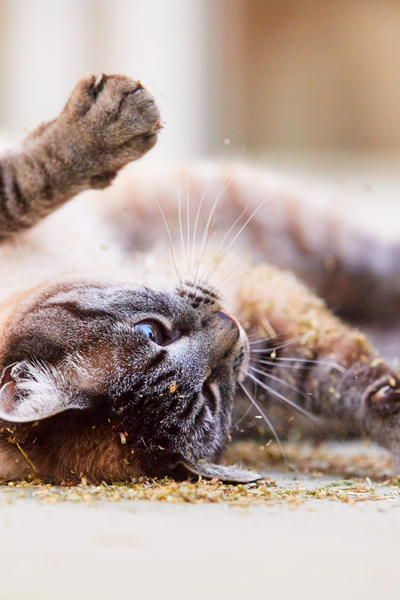
Cats & Catnip: Everything You Need to Know
Cats love catnip – as most people know. However, what is it about catnip that has cats going crazy for it? What exactly does catnip do to a cat, and does it have any nutritional value whatsoever?
In this blog, we’ll explore these questions (and a couple more) in depth, and go over some more quick facts you should know before giving your fluffy little ball of fur his or her favorite treat.
What Does Catnip Do to Cats?
Specialized glands in the leaves and flowers of the catnip or catmint plant produce a compound called nepetalactone. While there are other compounds produced by the plant that have similar effects, nepetalactone is the strongest of the lot. Cats are attracted to its odor, which binds to nasal receptors and results in euphoric behavior. Some other compounds in the plant affect neurotransmitters that inhibit central nervous system activity [1].
What does all this scientific babble mean? Well, in simple terms, a cat’s response to catnip is similar to a person reacting to a narcotic drug. They roll on their back, drool, lick the catnip and rub it over their body, run around wildly, or lie there purring. Depending on the cat, it may be dramatic and/or silly.
Is catnip like a drug for cats? The answer is mixed. In terms of reaction – yes. In terms of operation – we don’t really know. There is currently no information that shows that catnip operates in the same way that drugs like cannabis, marijuana or cocaine do.
What’s going on in your little kitty cat’s brain when she rolls around in catnip? Scientists aren’t sure. They can’t say for certain what’s happening and how their brain is being affected by the plant. What we do know, however, is that their response to catnip may involve opioid receptors, because when cats are given naloxone (and similar) to block opioid receptors in the central nervous system, the effects of catnip are minimized – sometimes even eliminated.
What Are the Benefits of Catnip?
Are there any benefits of giving your kitty catmint, apart from making you their favorite human? Yes, there are several! Here are some of the key benefits of giving your cat a bit of catnip every now and then:
1. It reduces anxiety
Catnip, like we stated earlier, produces ecstatic behavior in cats. So if your cat is anxious or
stressed, you can give him or her a little catnip to help them feel better. If you will be going out for an extended period of time and your cat has separation anxiety, the herb can also help with that.
Cats are creatures of habit, and any changes in their normal routine can lead to stress. So, if you anticipate any changes in routine, give your cat a little catnip. It will help your furry friend relax and calm down.
2. It can relieve pain
Catnip tea has analgesic properties, so if your cat is in pain, brew some tea with dried catnip flowers. To do this, place the flowers in a strainer, and place the strainer in boiling water. After it has soaked for a while, remove the flowers and give your cat the tea. To make it more appetizing, you can try using chicken broth instead of water.
Any cat that likes catnip will be happy to drink catnip tea, although they may not drink much of it. The magnitude of pain relief will depend on the severity of the pain and the amount of tea your cat consumes.
3. It has anti-inflammatory properties
If your cat has been scratching him or herself more than usual, it may be a sign that they have a skin condition. If you notice dry, flaky skin or rashes and bumps, that’s also a bad sign. So, get out the catnip and prepare a catnip tea bath. The anti-inflammatory properties present in this plant will have your cat feeling better in no time!
To make a catnip tea bath, simply dissolve a tablespoon of the stuff in a mug of boiling water, and add this mix to the bath water. Your cat will come along happily when they smell catnip, and if they don’t mind bath time, you should have no trouble getting them to bathe in it. If your cat isn’t fond of water, apply the mix topically to itchy spots with a rag dampened in the tea.
4. It acts as a muscle relaxant
This is great for both you and your pet. If either of you have aching muscles, take a catnip tea bath and you’ll soon feel better [2]. However, if your cat isn’t a fan of bath time, you can just give them some catnip tea to drink instead. Any cat that responds to catnip should happily drink it. Just make sure the tea isn’t very hot, or they could burn their tongue.
These were some of the benefits of giving your cat catnip or catmint. It can also be a great way to train your cat, so for example, you can try sprinkling or spraying catnip onto a scratching post to encourage them to use it, and to play more. Sprays are a great option for felines that get an upset tummy when they ingest catnip.
All You Need to Know About Catnip
Catnip is a plant whose leaves, stems and more are your cat’s best friend. In fact, they aren’t just your cat’s friend, but any cat’s – small or big. The plant is native to parts of Europe, the Middle East, central Asia, and parts of China.
Like previously mentioned, the plant contains nepetalactone, which is well-known as a “feline attractant”. Due to this reason the plant is often used for their enjoyment. Two out of three cats are attracted to the smell of catnip, and tend to paw at, lick, and chew it. This is followed by silly and/or aggressive behavior for five to fifteen minutes. The experience is generally enjoyable by pet and pet parent both.
Now let’s go over some frequently asked questions.
Are there any downsides of using catnip? It doesn’t have any negative or damaging effects on your cat, but some cats may display aggressive behavior and/or drool when they get ‘high’. If this is undesirable, you may want to limit their use of the plant. In some cases, felines may have vomiting or diarrhea after ingesting catmint. In this case, you can get them catnip filled toys or a spray.
Could your cat be allergic? Some, although extremely few, cats are allergic to catnip [3]. When introducing the plant to your kitty for the first time, watch them carefully for any signs that anything is amiss.
How often should you give your cat catnip? Avoid giving them catnip more than once a day, because with frequent use the herb may lose its charm. Use it as a fun treat and give it to your cat in moderation, or give it to them as a reward for good behavior, or as encouragement to form good habits.
How should you give your cat catmint? Catmint or catnip comes in many forms – fresh leaves that you can grow in your backyard, dried leaves and stems, crushed powder, catnip-filled toys, and as sprays. If one of these doesn’t work for your cat, you can try the others.
How much catnip to give your cat? One teaspoon or tablespoonful is usually enough.
Can you give catnip to kittens? Many cat experts feel that kittens younger than eight weeks should not be given catmint. It is likely that they may not respond to the herb even if given, because they are sexually immature at this age.
Why do some cats not respond to catnip? Whether or not your pet responds to the plant is determined by their genetic makeup. There is a gene that decides their reaction to catnip. If a cat inherits the dominant gene, they respond to the herb. Otherwise, they don’t.
What if your cat isn’t affected by catnip? It happens to roughly one cat in three, and if your cat happens to be one of those few you can try alternatives like valerian, matatabi, silver vine, and Tatarian honeysuckle wood.
Does catnip have any nutritional value for cats? Unfortunately, no. Catnip is for recreational use only. If you’re looking for healthy treats, try our products! You can read more about them below.
Spring Naturals – Healthy Pet Food for Your Fluffy Little Love Ball
Spring Naturals cares about the health of your pet. To reflect this, our product range includes healthy cat and dog foods in a variety of flavors, including chicken, lamb, salmon, and turkey for dogs and turkey, chicken, turkey & salmon, tuna, and tuna & chicken for cats. The best part is, these foods are grain-free and contain all-natural protein blended with whole vegetables and fruit. Our dinners are crafted to be the most nutritionally balanced and complete meal available. Browse our handcrafted recipes at SpringNaturals.com.
[1] livescience.com/does-catnip-get-cats-high.html
[2] mrbosscat.com/does-catnip-help-with-pain
[3] pettango.com/care_center/why-catnip-isnt-for-every-cat

Post a Comment!